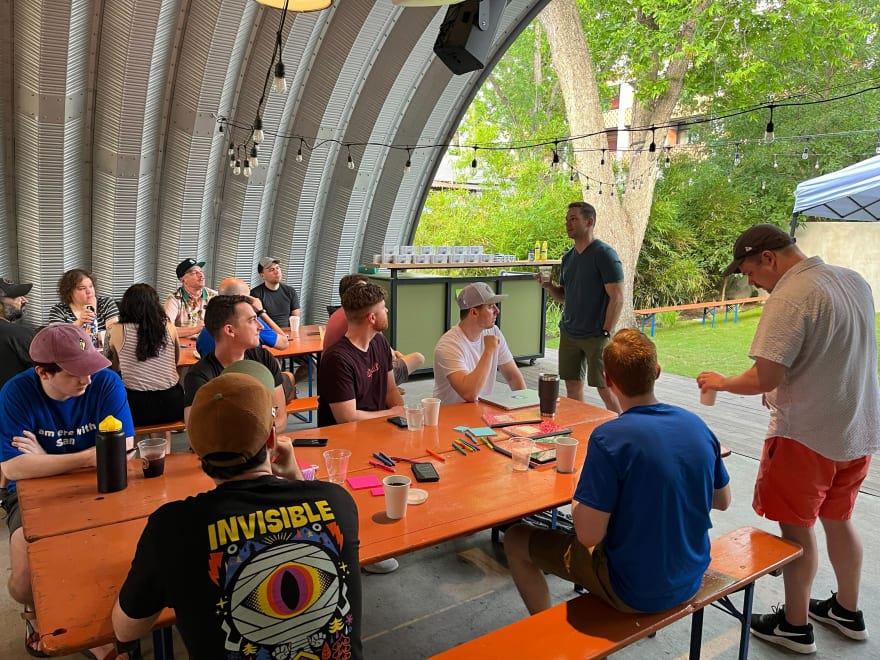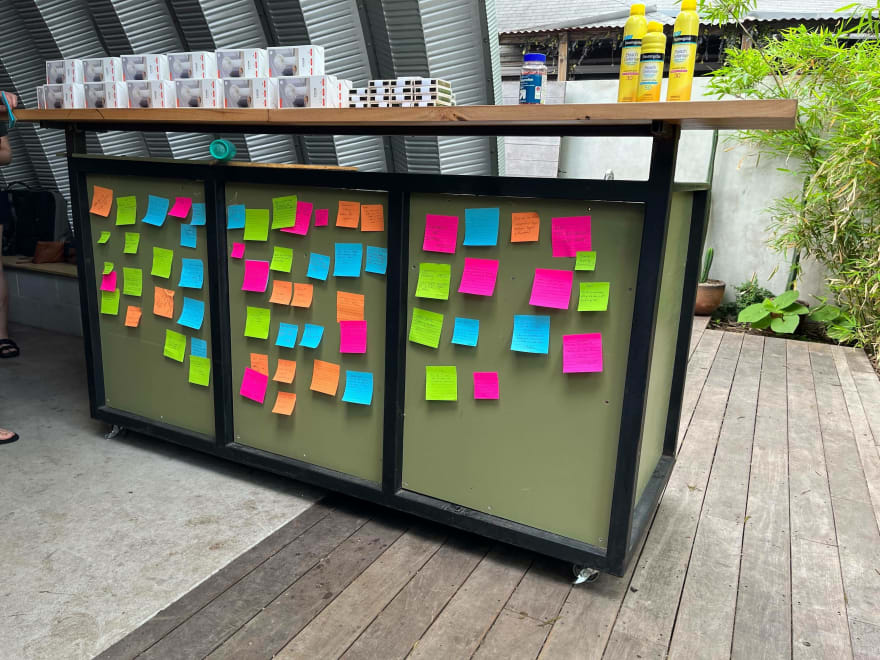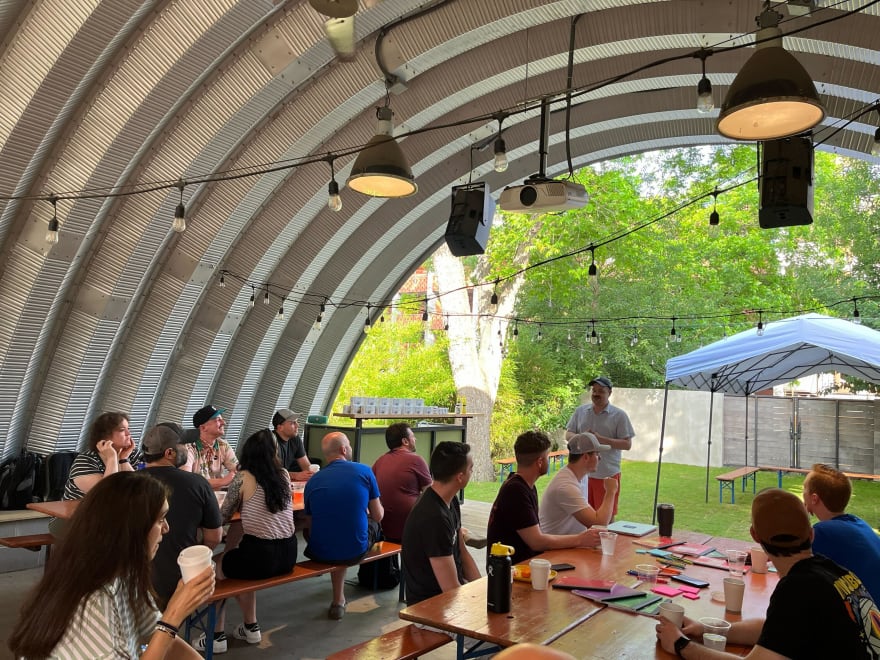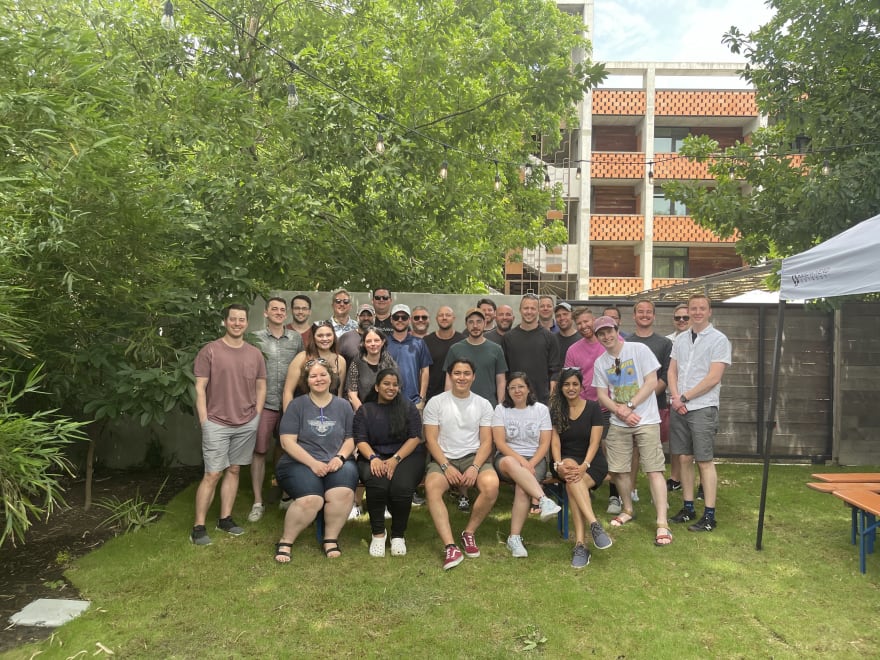In April 2022, the Signal Advisors technology team had an off-site, three-day rendez-vous in Austin, TX where our remote team got together, some team members meeting for the first time ever in person! We ate, drank, and were merry, but we were also incredibly productive, engaging in an Open Space each morning of our retreat.
In an Open Space meeting format, participants swarm to create their own agenda given a specific theme. Participants build the schedule and then attend the discussions they find most meaningful. To learn more about Open Space, I recommend this site.
Coordination
Coordinating the venue and supplies for the Open Space was incredibly simple due to its inherently flexible nature. In one run to Target, we grabbed notebooks for every attendee, an assortment of different colored pens, post-its of various sizes and colors, and some sunscreen to protect everyone from the Austin sun. Luckily our space was pretty well shaded, but you can never be too careful!
Setting up was simple: place the notebooks, post-its, and pens on each of the picnic-style tables before the attendees arrived for breakfast. That’s it! Done. No projector needed, no cords, no weird Bluetooth connectivity troubleshooting. We had everything we needed from the people who would be entering through the gate in about ten minutes and a few paper goods from the store.
Introduction to the Open Space format
As Matt and Sean introduced the theme—how can we double our capacity through people, process, and technology over the next year?—and the structure (or lack thereof) for our morning sessions for the next two days, you could see that everyone was engaged and eager to begin discussing the topics that they had either been thinking about for the last two weeks or that had been sparked in the moment. You could feel the buzz of excitement, a mixture of our distributed team meeting in person, many for the first time, and being able to effect change immediately in a way meaningful to each individual.
Once the format of the Open Space had been explained and the team understood the theme, we took about half an hour to come up with ideas for discussions, announcing them aloud as they were posted on our Idea Wall. It was amazing to watch people get immediately inspired by others, building topics and discussion points off topics just posted to the schedule wall. People, regardless of position or personality, added their topics to the board for the entire team’s consideration.
Once the ceremony of creating topics had been completed, all of the attendees voted for which topics either mattered most to them or topics that they saw could have the biggest impact on the team through our theme. People swarmed the board, making tick marks in different colored ink on a rainbow of post-it notes. Clear pain points and trends were identified, and those cards were brought up for discussion.
Note: There was definitely room for improvement here. Having 30 people swarm on a wall the size of 3'x5' was not the most efficient means of voting. We will be improving this process for next year with digital voting!
The discussions
We discussed a wide range of topics, from how to get more engineers involved in user experience to enhancing documentation and handoff between scrum teams to how to structure our team in the most effective way to yield the best results with the least amount of friction. Every topic had a leader, typically the person who suggested the discussion, and a note taker, ensuring that our talking points were all collected and action items were accounted for. What I did not expect, and what I really loved about this format of workshop, was that people who didn’t always speak up in Zoom meetings participated!
This has not been scientifically tested, but instead is a gut feeling as one of those people who participated in person but fails to speak up in Zoom meetings. The feeling of being in person with people that you’re spending quality time with allows you to be more open, to express your thoughts with them in a vulnerable manner. You don’t have to read body language through a small, rectangular box and hope that when you come off mute to say something, you’re not interrupting someone else. You’re also being encouraged to discuss topics that are meaningful to you, and you’re encouraged to move to a new topic or take a break if the conversation doesn’t energize you. You would think that an introvert’s worst nightmare would be being surrounded by thirty other people, and while you will certainly be tired by the end of the day, it’s invigorating to discuss the things that matter most to you with others who are also passionate about the same things.
This is not eight hours of small talk with co-workers. This is eight hours of vulnerable, open, deep conversations with folks hoping to solve the same problem. It brought our team closer together—in fact, of the 17 people who responded to the post-retreat feedback survey, 14 strongly agreed with the statement “I feel more connected to the technology team as a whole,” while the remaining three moderately agreed.
Learnings
- Giving people enough time before the first session to get comfortable with one another allowed everyone to feel more comfortable challenging each other and discussing difficult topics when the time came. Have attendees on site a day before, if possible, especially if you work in a distributed manner, if your individual team members do not collaborate often, or if you have a lot of new hires. Engage in team building, ice breaker activities or share a meal together.
- Announcing the theme two weeks early gave our team members enough time to come prepared, but not so much time that they overthought or pushed it out of their minds completely.
- Keeping things analog with notebooks and post-its helped to reduce the distractions of opening computers and checking email, Slack, or GitHub. The only downfall came to voting time, which we will address for next year.
- Re-emphasizing the law of mobility several times throughout the sessions emboldened team members who might otherwise have stayed in a breakout discussion that was unproductive for them.
- Take notes and create follow up items in the sessions. When returning back to your day-to-day work, these fruitful and productive discussions can often fall off due to lack of accountability and ownership. Keep the momentum by assigning owners and creating follow up meetings while you're in the moment.
Conclusion
Overall, the Open Space seemed like a great success for our team. We took immediate action in a few areas by restructuring our scrum teams, prioritizing the product backlog, and creating channels of communication for ongoing discussions related to the topics. 100% of survey respondents either strongly or moderately agreed with the statements “I felt like the Open Space discussions were productive” and “I felt like I could participate in the Open Space discussions.” We are all excited to iterate on this format for our team retreat next spring!
Interested in a career at Signal Advisors? Check us out here!






Top comments (0)